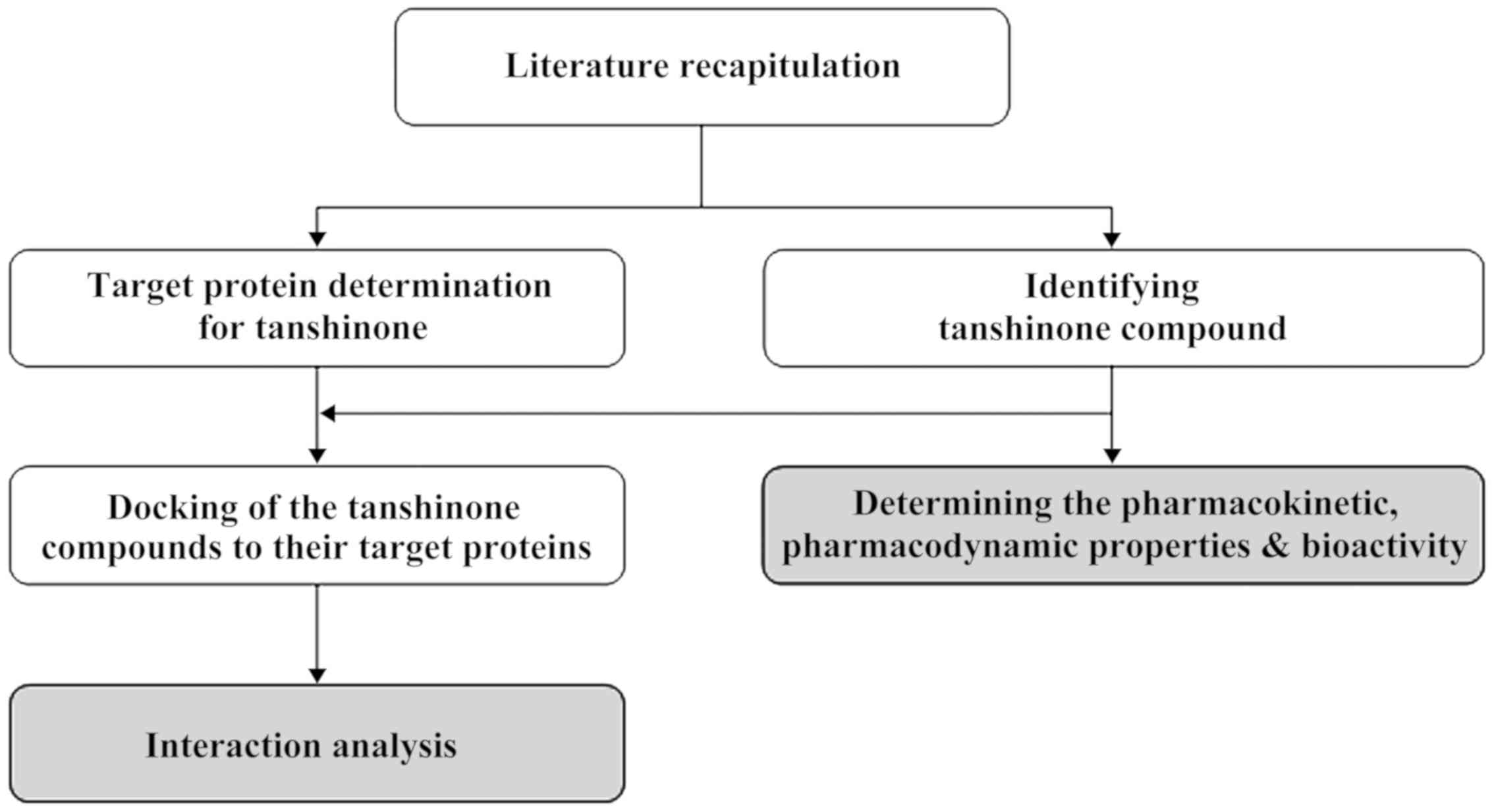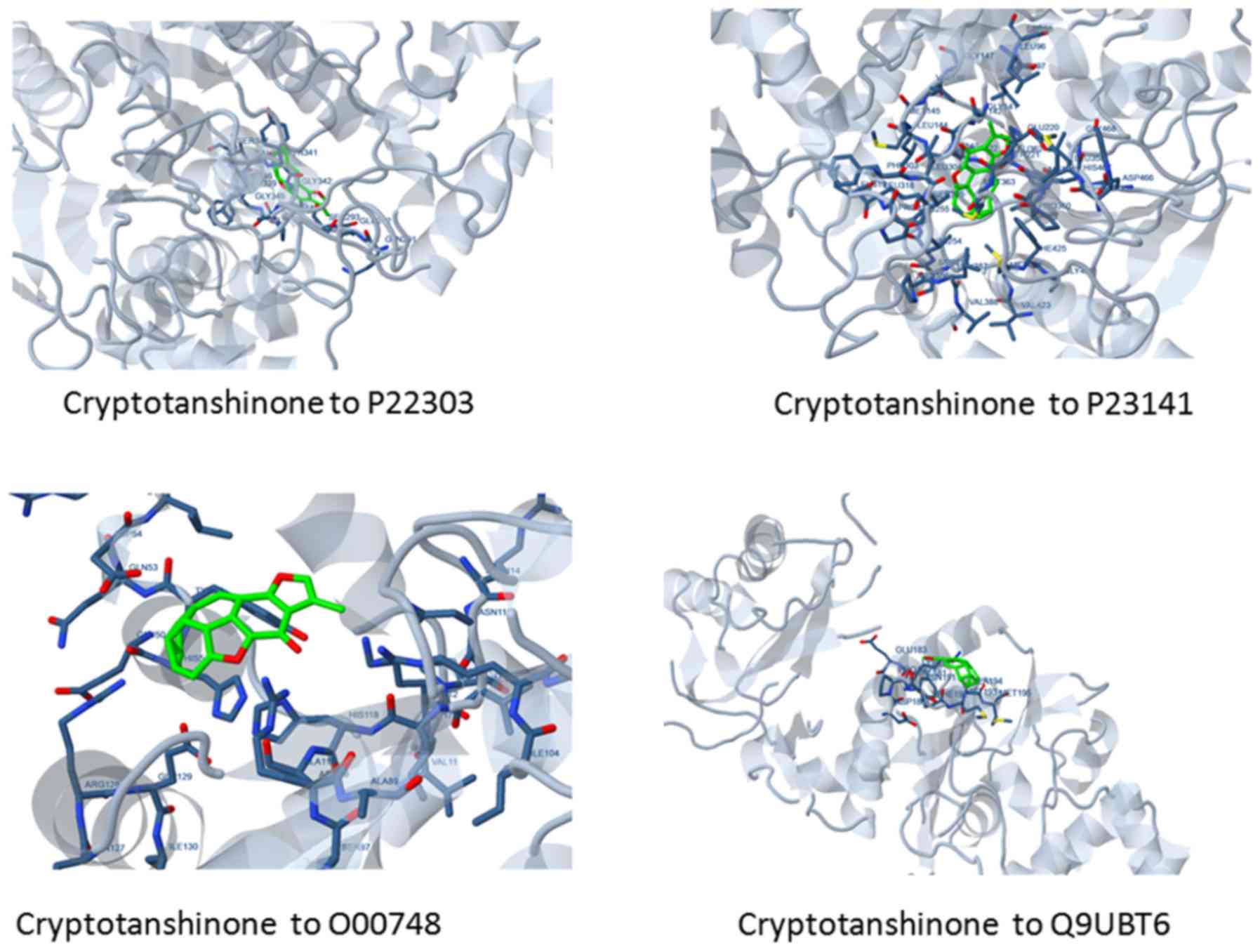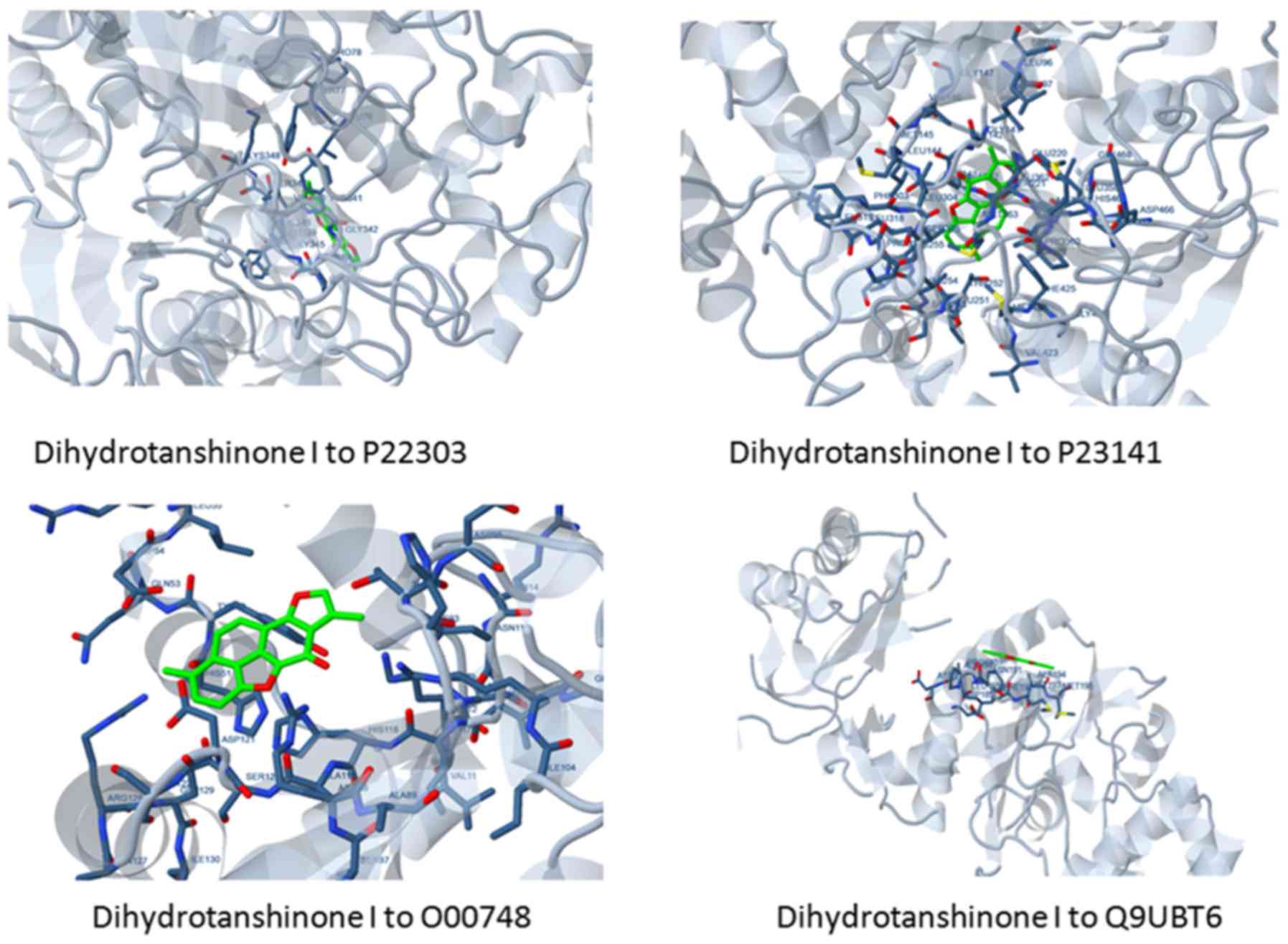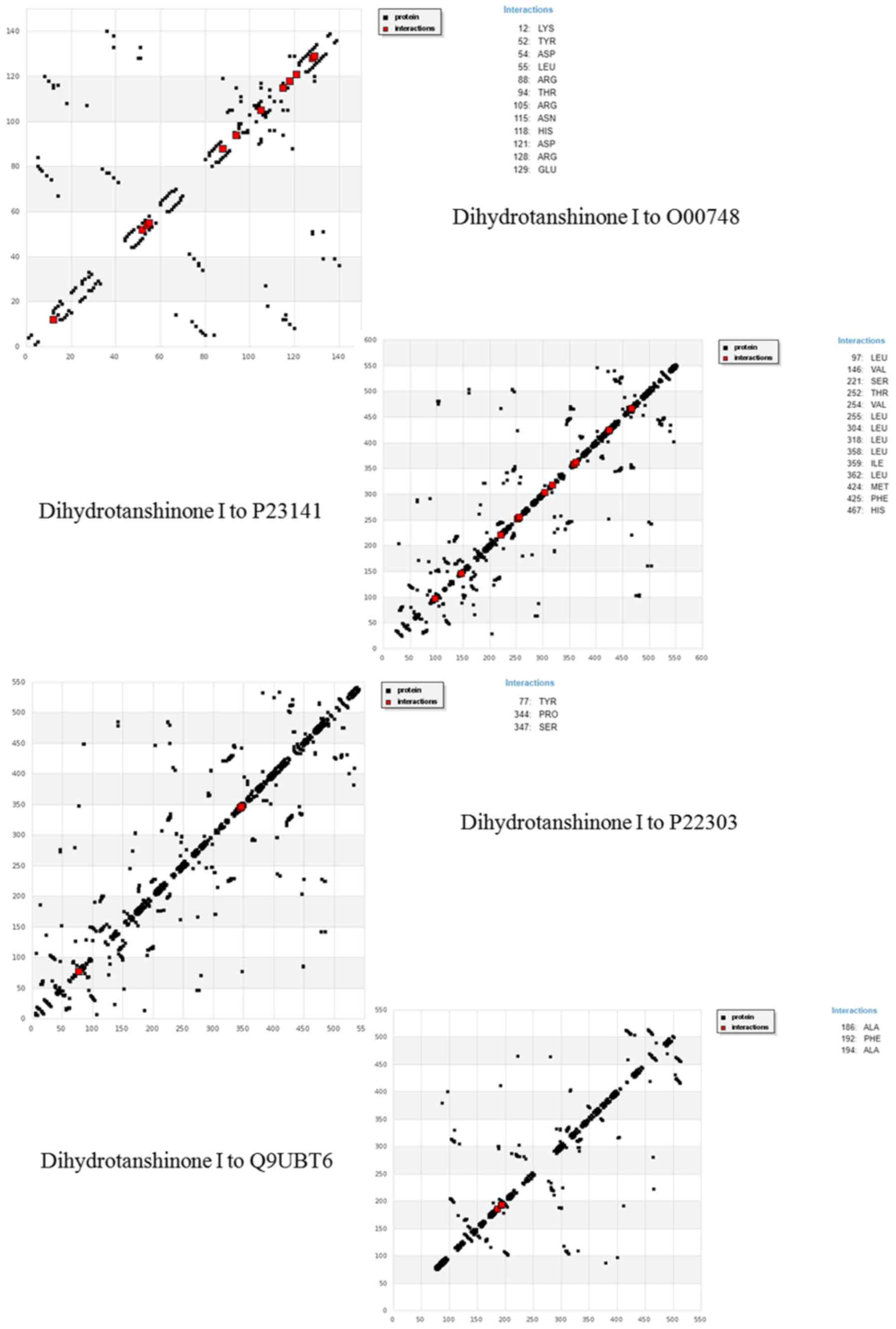Introduction
Tanshinones are a class of abietane diterpene
compounds extracted from the well-known Chinese herbal plant,
Salvia miltiorrhiza (Red sage or Chinese sage or Danshen)
viz., a perennial plant with a height between 90 to 1,200 m, and
which is highly valued for its roots which are religiously employed
for medical purposes in traditional Chinese medicinal practices
(1). The plant is a ‘part and
parcel’ of the Chinese and the Japanese territories and usually
grows in grassy, yet mushy locations, such as forests or hillsides
(2). This herb has been already
tested for the treatment of chronic obstructive pulmonary disease
(COPD), and has shown to be highly effective (3,4).
Moreover, the abietane-type diterpene compound, tanshinone, has
been used as a therapeutic remedy for a myriad of diseases, such as
coronary artery and vascular diseases, stroke, hyperlipidemia,
endangiitis, arthritis and hepatitis (5). The compound has also been employed for
the treatment of breast cancer and inflammatory disorders (1). This study examined the
anti-inflammatory properties of this compound.
Inflammation usually occurs when the body comes into
contact with any harmful pathogen, irritant or when cell damage
occurs. This type of inflammation is simply a function of
self-defense, or it can occur as a protective mechanism of the body
(6). With the help of an exhaustive
literature recapitulation, it can be discerned that there are
>100 compounds which have been screened from Salvia
miltiorrhiza and have been classified as per their chemical
properties and structural capabilities. There are basically two
categories in which the classification has been laid down: i)
Water-soluble compounds, which comprise compounds, such as
salvianolic A-G and lithospermic acid B; and ii) lipid-soluble
category compounds which encapsulate the compounds tanshinone IIA,
dihydrotanshinone I (https://pubchem.ncbi.nlm.nih.gov/compound/11425923;
https://toxnet.nlm.nih.gov/cgi-bin/sis/search2/r?dbs+hsdb:@term+@rn+@rel+87205-99-0)
and cryptotanshinones (https://pubchem.ncbi.nlm.nih.gov/compound/160254)
(7,8). The lipid-soluble categories of the
compounds have been shown to have anti-inflammatory properties
(5).
In this study, we focused our attention on
tanshinone compounds which have the potential to act as
anti-inflammatory agents for various inflammation-based diseases.
Furthermore, we targeted these compounds for a molecular docking
and interaction analyses to their counterpart proteins. The basic
mode of operation of this study has been showcased in the form of a
flowchart as shown in Fig. 1.
Materials and methods
Compounds
Query tanshinone compounds were retrieved from the
ChEMBL database (9) along with their
target proteins. A list of the query compounds and their target
proteins is presented in Tables
I–V. An extensive literature
recapitulation was accomplished in order to search for
lipid-soluble compounds, and in particular for tanshinone
compounds. Initially, 18 compounds were retrieved which exhibited
anti-inflammatory acitivity (5). An
exhaustive filtering was carried out so as to retrieve the best,
optimal and specific tanshinone compounds. By using the ChEMBL
database, 4 best keyword matching the compounds were obtained
namely, tanshinone IIA (CHEMBL187266), tanshinone IIA sulfone
(CHEMBL1473252), dihydrotanshinone I (CHEMBL227075) and
crytotanshinone (CHEMBL187460). Out of these 4, only 2,
dihydrotanshinone I and cryptotanshinone were selected for further
analysis as they had a greater number of similar target
proteins.
 | Table I.List of target proteins for tanshinone
IIA. |
Table I.
List of target proteins for tanshinone
IIA.
| ChEMBL ID | Description | UniProt ID |
|---|
| ChEMBL4832 | Transcription
initiation factor | P52655 |
| ChEMBL3474 | Phospholipase A2 grp
IIA | P14555 |
| ChEMBL5841 | Low affinity
immunoglobulin gamma-Fc region receptor IIA | P12318 |
| ChEMBL2189151 | Myosin-9 | P35579 |
| ChEMBL5616 | Activin receptor type
2A | P27037 |
| ChEMBL3797012 | Tubulin β-2A
chain | Q13885 |
| ChEMBL4444 | Vitamin Κ-dependent
protein-C | P04070 |
| ChEMBL1905 | Fibronectin receptor
β | P05556 |
| ChEMBL3885597 | ITGB1-ITGA9
complex | PO5556, Q13797 |
| ChEMBL3430895 | Integrin α-10/itegrin
beta-1 | P05556, O75578 |
| ChEMBL3137278 | Integrin α-1/β-1
complex | P05556, P56199 |
| ChEMBL1907599 | Integrin α-4/β-1 | P05556, P13612 |
| ChEMBL2111407 | Integrin α-V/β-1 | P05556, P06756 |
| ChEMBL3885596 | ITGA-6-ITGB1
complex | P05556, P23229 |
| ChEMBL2095226 | Integrin α-5/β-1 | P05556, P08648 |
 | Table V.List of common target proteins for
dihydrotanshinone I and cryptotanshinone. |
Table V.
List of common target proteins for
dihydrotanshinone I and cryptotanshinone.
| ChEMBL ID | Description | UniProt ID |
|---|
| ChEMBL2265 | Acyl coenzyme A:
cholesterol acyltransferase | P23141 |
| ChEMBL3180 | Carboxylesterase
2 | O00748 |
| ChEMBL220 |
Acetylcholinesterase | P22303 |
| ChEMBL5365 | DNA Pol kappa | Q9UBT6 |
Determination of pharmacokinetic and
pharmacodynamic properties and bioactivity of tanshinone
compounds
The acknowledgement of the binding of tanshinone
compounds to their target proteins was accomplished using
Molinspiration (http://www.molinspiration.com/cgi-bin/properties)
and DrugBank (10,11). ADME expands to Absorption,
Distribution, Metabolism and Excretion. ADME properties plays
pivotal role during the process of drug design due to the fact that
these account for the failure of approximately 60% of all drugs
during clinical phases. Traditionally, these properties are
assessed at the end of the drug development process, but now-a-days
it is applied at an early phase in order to filter out molecules
with poor ADME properties. DrugBank (10,11) is
an inclusive, open and freely-available online database which
encases information on drugs and their targets. It a type of
encyclopedia of drugs. Molinspiration is a cheminformatics tool,
which is an online based tool used to calculate molecular
properties, such as molecular weight, the number of atoms, the
number of hydrogen donor atoms, the number of hydrogen acceptor
atoms, and the polar surface area, of small molecules (http://www.molinspiration.com/cgi-bin/properties).
Active site prediction and docking
analysis
Active site prediction is a state-of-the-art
approach which helps in the determination of the
sites/pockets/clefts in the protein structures, where any ligand or
any small molecule can bind to it. Once the binding cleft or pocket
is known, docking determines their affinity and binding stability
and root mean square deviation (RMSD) value, etc. Active Site
prediction tools, such as TM Site (12), is a tool used for the identification
of the ligand binding template sequences from the BioLip protein
functional database (13) by
utilizing profile sequence differentiation and by attaching
sub-structures (12); COACH
(14) provides reliable results
which can be used for docking analyses or any other research;
COFACTOR (14) begins from the
tertiary structure of the protein and threads the protein query
through the BioLip functional database using global and local
matches to determine functional and active sites within the query
protein (14); these were employed
for the purposes of this study. An online docking server, Docking
Server (15), which is based on
AutoDock, was employed for docking purposes thereafter. This online
server has an inbuilt parameter which allows the user to select the
site of docking in the target protein
Interaction analysis
After docking, many interactions are formed between
a protein and its ligand, which are essential for the stability of
the complex structure. The CCP4 tool (16) can be downloaded from the CCP4 suite
from the main webpage (http://www.ccp4.ac.uk/docs.php. Once the tool is
downloaded, the user finds that the tool has a simple GUI with a
number of options, such as structural analysis, which again
contains many options for studying the protein structures in detail
(16). Protein Interaction Ligand
Profiler (PLIP) (17), unlike other
interactive tools, does not require any structural preparations and
returns a list of interactions, mostly 7 types, such as hydrogen
bonding, π-stacking, hydrophobic bonds, π-interactions and polar
bonds.
Results
Pharmacokinetic, pharmacodynamic
properties and bioactivity investigation
As a primary step towards confirming whether
tanshinone compounds have the potential to be ‘drug-like’, i.e., it
has properties such as solubility in water and other solvents,
potency at the biological targets, ligand efficiency, and so on. It
was exposed to Molinspiration prior to docking and interaction
studies. The pharmacokinetic and physiochemical results are
presented in Table VI. Pre-ADME
evaluation showcases that tanshinone compounds are very much
‘drug-like’ as it does not violate any thumb rule, such as
Lipinski's, Ghose's, Veber's and Eden's rule. Dihydrotanshinone I
and cryptotanshinone have quite similar molecular weights (278.3
and 296.3 kDa, respectively), and their topological surface area
was also equivalent viz., 43.38. Cryptotanshinone had an edge when
compared to dihydrotanshinone I, as it was a better ion channel
modulator. The plasma membrane has a bi-lipid layer, and only
substances which are semi-permeable or completely permeable can
pass through it. Cryptotanshinone being a good ion channel
modulator, can gain access easily through the plasma membrane and
can reach the other parts of the body easily via the blood.
 | Table VI.Bioactivity, pharmacokinetic and
pharmacodynamic properties of dihydrotanshinone I and
cryptotanshinone. |
Table VI.
Bioactivity, pharmacokinetic and
pharmacodynamic properties of dihydrotanshinone I and
cryptotanshinone.
| A, Bioactivity |
|---|
|
|---|
| Compound | GPCR ligand | Ion xhannel
modulator | Kinase
inhibitor | Nuclear receptor
ligand | Protease
inhibitor | Enzyme
inhibitor |
|---|
| Dihydrotanshinone
I | 0.03 | 0.00 | 0.04 | 0.09 | −0.15 | 0.28 |
|
Cryptotanshinone | 0.24 | 0.36 | −0.07 | 0.31 | −0.14 | 0.46 |
|
|
| B,
Pharmacokinetic and pharmacodynamic properties |
|
|
Compound | miLogP | TPSA | natoms | MW | nON | nOHNH |
nViolations | Volume |
|
| Dihydrotanshinone
I | 3.51 | 43.38 | 21 | 278.3 | 3 | 0 | 0 | 247.4 |
|
Cryptotanshinone | 3.83 | 43.38 | 22 | 296.3 | 3 | 0 | 0 | 276.1 |
As regards their bioactivity, it can be discerned
that both exhibit a good overall bioactivity; however,
cryptotanshinone again surpasses dihydrotanshinone. Bioactivity
heavily depends on whether the ligand of interest is a G-protein
coupled receptor (GPCR) ligand or not. GPCRs are mandatory as to
when an external signaling molecule (ligand) binds to a GPCR; it
leads a conformational alteration in the GPCR triggering an
affiliation between the GPCR and a nearby G protein. This
interaction is mandatory for the protein to become activated, in
turn leading to secondary messaging in the body (16). Cryptotanshinone is a better GPCR
ligand (0.24) when compared to dihydrotanshinone I (0.03).
AutoDock is a based online web-server;
Docking Server was employed for docking
The results were obtained from this analysis may
prove helpful in the opening of a new research avenues. It is known
that the ligands, dihydrotanshinone I and cryptotanshinone hold a
surface binding to 4 target proteins. Figs. 2 and 3
showcase the surface binding of dihydrotanshinone I and
cryptotanshinone with P23141, O00748, P22303 and Q9UBT6, which
refers to the planar surface of the docking site of the target
proteins. Furthermore, it hints to a rigid docking, which is surely
a rare case. Interaction analysis discerned that the ligands carry
out mainly 4 types of interactions with the receptor proteins
namely, hydrogen bonds, hydrophobic interactions, polar bonds and
π-π interactions. The complete docking affinities and energy
estimates re provided in Table
VII, while interaction details are presented in Table VIII.
 | Table VII.Binding affinities and free energy
estimation of the docked cryptotanshinone and dihydrotanshinone I
to its target proteins. |
Table VII.
Binding affinities and free energy
estimation of the docked cryptotanshinone and dihydrotanshinone I
to its target proteins.
| A,
Cryptotanshinone |
|---|
|
|---|
| Target protein | Estimated free
binding energy | Estimated
inhibition constant (Ki) | vDW+Hbond + desolv
energy | Electrostatic
energy | Total
intramolecular energy | Frequency | Interact.
surface |
|---|
| O00748 | −5.24 kcal/mol | 145.24 µM | −5.09 kcal/mol | −0.14 kcal/mol | −5.24 kcal/mol | 100% | 638.763 |
| P23141 | −7.06 kcal/mol | 6.68 µM | −7.11 kcal/mol | +0.05 kcal/mol | −7.06 kcal/mol | 100% | 46.8.499 |
| P22303 | −5.78 kcal/mol | 57.64 µM | −5.69 kcal/mol | −0.09 kcal/mol | −5.78 kcal/mol | 100% | 441.5 |
| Q9UBT6 | −0.51 kcal/mol | 425.86 µM | −0.36 kcal/mol | −0.14 kcal/mol | −0.51 kcal/mol | 10% | 430.213 |
|
| B,
Dihydrotanshinone I |
|
| Target
protein | Estimated free
binding energy | Estimated
inhibition constant (Ki) | vDW+Hbond +
desolv energy | Electrostatic
energy | Total
intramolecular energy |
Frequency | Interact.
surface |
|
| O00748 | −4.59 kcal/mol | 428.85 µM | −4.37 kcal/mol | −0.22 kcal/mol | −4.59 kcal/mol | 100% | 658.163 |
| P23141 | −3.88 kcal/mol | 1.44 µM | −3.90 kcal/mol | +0.03 kcal/mol | −3.88 kcal/mol | 70% | 482.697 |
| P22303 | −4.72 kcal/mol | 344.74 µM | −4.75 kcal/mol | +0.03 kcal/mol | −4.72 kcal/mol | 60% | 455.875 |
| Q9UBT6 | +0.03 kcal/mol | − | +0.37 kcal/mol | −0.14 kcal/mol | −0.04 kcal/mol | 20% | 416.477 |
 | Table VIII.Interactions formed by
dihydrotanshinone I and cryptotanshinone with the receptor targets,
O00748, P23141, P22303 and Q9UBT6. |
Table VIII.
Interactions formed by
dihydrotanshinone I and cryptotanshinone with the receptor targets,
O00748, P23141, P22303 and Q9UBT6.
| A,
Dihydrotanshinone I |
|---|
|
|---|
| Hydrogen bonds | Hydrophobic
bonds | π-π
Interactions | Polar bonds |
|---|
| O00748 |
| O2()-ARG105 | C1()-LEU55 | C1()-TYR52;
C10()-TYR52; C14()-TYR52; C4()-HIS118; C6()-HIS118,
C12()-HIS118 | O2()-ARG88;
O3()-ARG88; O3()-HIS11 |
| P23141 |
|
| C17()-LEU97;
C15()-LEU97; C16()-LEU97; C17()-VAL146; C7()-VAL254; C6()-VAL254;
C8()-VAL254; C18()-VAL254; C6()-LEU255; C7()_LEU255; C5()-LEU318;
C6()-LEU318; C15()-358; C1()-ILE359; C2()-ILE359; C13()-LEU362;
C15()-ILE362, C16()-ILE362; C17()-ILE362; C8()-MET424;
C18()-MET424; C18()-PHE425 | C2()-PHE425;
C1()-HIS467; C2()-HIS467 | O1()-HIS467 |
| P22303 |
|
| C18()-TYR77;
C13()-PRO344; C16()-PRO344; C17()-PRO344 |
|
|
| Q9UBT6 |
| O1()-ALA194 | C18()-ALA186;
C18()-PHE192; C1()-ALA194; C10()-ALA194; C14()-ALA194 | C3()-PHE192;
C8()-PHE192; C1()-PHE192; C2()-PHE192; C7()-PHE192 |
|
|
| B,
Cryptotanshinone |
|
| Hydrogen
bonds | Hydrophobic
bonds | π-π
Interactions | Polar
bonds |
|
| O00748 |
|
| C19()-LEU97;
C17()-LEU97; C18()-LEU97; C19()-VAL146; C7()-VAL254; C8()-VAL254;
C13()-LEU304; C14()-LEU304; C5()-LEU318; C6()-LEU318; C17()-LEU358;
C1()-ILE359, C9()-ILE359, C10()-ILE359; C17()-LEU362; C18()-LEU362;
C19()-LEU362; C7()-LEU387; C9()-387; C7()-MET424; C8()-MET424;
C9()-MET424; C10()-MET424; C1()-HIS467 | C10()-PHE425 | O1()-HIS467 |
| P23141 |
|
| C19()-LEU97;
C17()-LEU97; C18()-LEU97; C19()-VAL146; C7()-VAL254; C8()-VAL254;
C13()-LEU304; C14()-LEU304; C5()-LEU318; C6()-LEU318; C17()-LEU358;
C1()-ILE359, C9()-ILE359, C10()-ILE359; C17()-LEU362; C18()-LEU362;
C19()-LEU362; C7()-LEU387; C9()-387; C7()-MET424; C8()-MET424;
C9()-MET424; C10()-MET424; C1()-HIS467 | C10()-PHE425 | O1()-HIS467 |
| P22303 |
|
| C13()-PRO344 |
|
|
| Q9UBT6 |
| O2()-LYS182 | C19()-PHE192;
C7()-MET193; C9()-MET193; C6()-MET193; C13()-ALA194 | C17()-PHE192;
C18()-PHE192; C15()-PHE192 |
|
Many other interactions were formed apart from the
ones mentioned in Table VIII.
Figs. 4 and 5 encapsulate the interaction plots for all
the 4 target proteins with cryptotanshinone and dihydrotanshinone
I, respectively. Exploration and exploitation are the two key
factors in data analysis. HBD plots are simply interactive plots
which show interactions of amino acid residues with the ligand.
They help to understand the interaction quality between the
receptors and ligands, which in turn helps to learn more about the
flexible nature of the protein domains. The interactive plots shown
in Fig. 4 clearly indicate that
cryptotanshinone has a better affinity and binding to its target
receptors. The interactions also suggest that the docking between
cryptotanshinone and O00748, P22303, P23141 and Q9UBT6 is a
flexible docking.
Discussion
The in silico approach has aimed to place some
credit on the anti-inflammatory-based herbal compound, tanshinone.
Through various bioinformatics techniques, we can identify and
modify the drugs that are useful for the treatment of inflammation,
and this may lead to novel insight being obtained into new aspects
of anti-inflammatory disorders, which are less known to society,
indicating vindictively the fact that our how society carries a
lackadaisical approach towards such issues. It is important to be
up well informed and to carry out detailed investigations of the
proteins involved in anti-inflammation and of the traditional
herbal medications which are being used to treat this disorder. A
great amount of knowledge has been gained which needs to be
synergistically collated and discussed. A gateway of research for
elucidating inflammation and its treatment using herbal medicines
was the main lead in this study. More than 15 protein targets were
retrieved out of which only 4 target receptors were selected and
examined. Along with this, lipid-soluble compounds, which were
specific to the tanshinone class, which are being used in the
treatment of inflammation were also highlighted, out of which, 2
compounds, dihydrotanshinone I and cryptotanshinone were selected
with an aim of providing a new research avenue for the elucidation
of the detailed mechanisms responsible for the pathogenesis of
inflammatory diseases. These are multi-faceted herbal compounds
whose benefits can be extracted and can be utilized effectively for
human well-being and healthcare. From the treatment of breast
cancer to inflammatory diseases, a herbal medication can prove to
be effective. It is surely their agrarian nature which makes these
medications a ‘blessing in disguise’. In this study, an imperforate
strategy was laid down in order to recognize the abilities of
dihydrotanshinone I and crytptotanshinone with their
pharmacokinetic, pharmacodynamic and physiocochemical properties,
and ultimately to expose the ligands and the receptors proteins to
docking analysis and to determine the binding affinity. Moreover,
interactions analyses were accomplished successfully to identify
the interactions formed between both dihdrotanshinone I and
cryptotanshinone, and the 4 target proteins.
The bioactivity properties and various other
pharmacokinetic and pharmacodynamic analyses discerned that
crytptotanshinone was more effective than dihydrotanshinone and was
more ‘drug-like’ than its counterpart. It has a better solubility,
permeability and holds potential for use as an anti-inflammatory
agent.
Docking analysis and interaction analyses were
performed and revealed that there is an affinity between
cryptotanshinone and O00748, P23141 and Q9UBT6, and interactions
such as hydrogen bonds, π-π bonds, hydrophobic bonds are formed
between the ligand and the receptor proteins. Hydrogen bonding
between the ligand and the proteins indicate that the complexes
have a good stability.
Acknowledgements
Not applicable.
Funding
This study was supported by the Medical cross
project of Shanghai Jiao Tong University (no. YG2016QN74).
Availability of data and materials
The datasets used and/or analyzed during the current
study are available from the corresponding author on reasonable
request.
Authors' contributions
ZR, LN and LH conceived and designed the study. ZR,
LN, LH, RR, ZX, WD and LJ were responsible for the collection and
assembly of data, data analysis and interpretation. ZR, LN and LH
were involved in the writing of the manuscript. All authors have
read and approved the final manuscript.
Ethics approval and consent to
participate
Not applicable.
Patient consent for publication
Not applicable
Competing interests
The authors declare that they have no competing
interests.
References
|
1
|
Zhang Y, Jiang P, Ye M, Kim SH, Jiang C
and Lü J: Tanshinones: Sources, pharmacokinetics and anti-cancer
activities. Int J Mol Sci. 13:13621–13666. 2012. View Article : Google Scholar : PubMed/NCBI
|
|
2
|
Ji XY, Kwong-Huat Tan B, Huang SH,
Whiteman M, Zhu YC, Linz W, Duan W and Zhu YZ: Effects of Salvia
miltiorrhiza after acute myocardial infarction in rats. Novel
Compounds from Natural Products in the New Millennium. World
Scientific Publishing Co. Pte Ltd.; Singapore: pp. 183–195. 2004,
View Article : Google Scholar
|
|
3
|
Li D, Wang J, Sun D, Gong X, Jiang H, Shu
J, Wang Z, Long Z, Chen Y, Zhang Z, et al: Tanshinone IIA sulfonate
protects against cigarette smoke-induced COPD and down-regulation
of CFTR in mice. Sci Rep. 8:3762018. View Article : Google Scholar : PubMed/NCBI
|
|
4
|
Guan R, Wang J, Li Z, Ding M, Li D, Xu G,
Wang T, Chen Y, Yang Q, Long Z, et al: Sodium Tanshinone IIA
Sulfonate Decreases Cigarette Smoke-Induced Inflammation and
Oxidative Stress via Blocking the Activation of MAPK/HIF-1α
Signaling Pathway. Front Pharmacol. 9:2632018. View Article : Google Scholar : PubMed/NCBI
|
|
5
|
Gao H, Sun W, Zhao J, Wu X, Lu JJ, Chen X,
Xu QM, Khan IA and Yang S: Tanshinones and diethyl blechnics with
anti-inflammatory and anti-cancer activities from Salvia
miltiorrhiza Bunge (Danshen). Sci Rep. 6:337202016. View Article : Google Scholar : PubMed/NCBI
|
|
6
|
Staniforth V, Wang SY, Shyur LF and Yang
NS: Shikonins, phytocompounds from Lithospermum erythrorhizon,
inhibit the transcriptional activation of human tumor necrosis
factor alpha promoter in vivo. J Biol Chem. 279:5877–5885. 2004.
View Article : Google Scholar : PubMed/NCBI
|
|
7
|
Chen W, Lu Y, Chen G and Huang S:
Molecular evidence of cryptotanshinone for treatment and prevention
of human cancer. Anticancer Agents Med Chem. 13:979–987. 2013.
View Article : Google Scholar : PubMed/NCBI
|
|
8
|
Kim S, Chen J, Cheng T, Gindulyte A, He J,
He S, Li Q, Shoemaker BA, Thiessen PA, Yu B, et al: PubChem 2019
update: Improved access to chemical data. Nucleic Acids Res.
47(D1): D1102–D1109. 2019. View Article : Google Scholar : PubMed/NCBI
|
|
9
|
Gaulton A, Bellis LJ, Bento AP, Chambers
J, Davies M, Hersey A, Light Y, McGlinchey S, Michalovich D,
Al-Lazikani B, et al: ChEMBL: A large-scale bioactivity database
for drug discovery. Nucleic Acids Res. 40(D1): D1100–D1107. 2012.
View Article : Google Scholar : PubMed/NCBI
|
|
10
|
Law V, Knox C, Djoumbou Y, Jewison T, Guo
AC, Liu Y, Maciejewski A, Arndt D, Wilson M, Neveu V, et al:
DrugBank 4.0: Shedding new light on drug metabolism. Nucleic Acids
Res. 42(D1): D1091–D1097. 2014. View Article : Google Scholar : PubMed/NCBI
|
|
11
|
Wishart DS, Knox C, Guo AC, Cheng D,
Shrivastava S, Tzur D, Gautam B and Hassanali M: DrugBank: A
knowledgebase for drugs, drug actions and drug targets. Nucleic
Acids Res. 36 (Suppl 1):D901–D906. 2008. View Article : Google Scholar : PubMed/NCBI
|
|
12
|
Xu J and Zhang Y: How significant is a
protein structure similarity with TM-score = 0.5? Bioinformatics.
26:889–895. 2010. View Article : Google Scholar : PubMed/NCBI
|
|
13
|
Roy A, Yang J and Zhang Y: COFACTOR: An
accurate comparative algorithm for structure-based protein function
annotation. Nucleic Acids Res 40 (W1). W471–477. 2012. View Article : Google Scholar
|
|
14
|
Yang J, Roy A and Zhang Y: BioLiP: A
semi-manually curated database for biologically relevant
ligand-protein interactions. Nucleic Acids Res. 41(D1):
D1096–D1103. 2013. View Article : Google Scholar : PubMed/NCBI
|
|
15
|
Bikadi Z and Hazai E: Application of the
PM6 semi-empirical method to modeling proteins enhances docking
accuracy of AutoDock. J Cheminform. 1:152009. View Article : Google Scholar : PubMed/NCBI
|
|
16
|
Winn MD, Ballard CC, Cowtan KD, Dodson EJ,
Emsley P, Evans PR, Keegan RM, Krissinel EB, Leslie AG, McCoy A, et
al: Overview of the CCP4 suite and current developments. Acta
Crystallogr D Biol Crystallogr. 67:235–242. 2011. View Article : Google Scholar : PubMed/NCBI
|
|
17
|
Salentin S, Schreiber S, Haupt VJ, Adasme
MF and Schroeder M: PLIP: Fully automated protein-ligand
interaction profiler. Nucleic Acids Res 43 (W1). W443–447. 2015.
View Article : Google Scholar
|



















